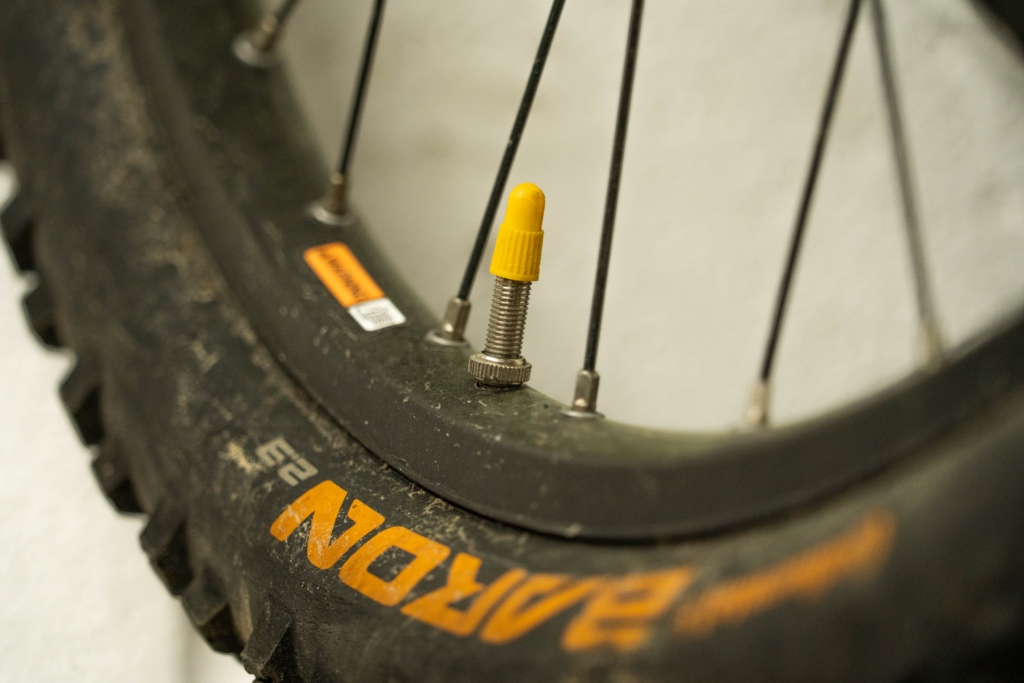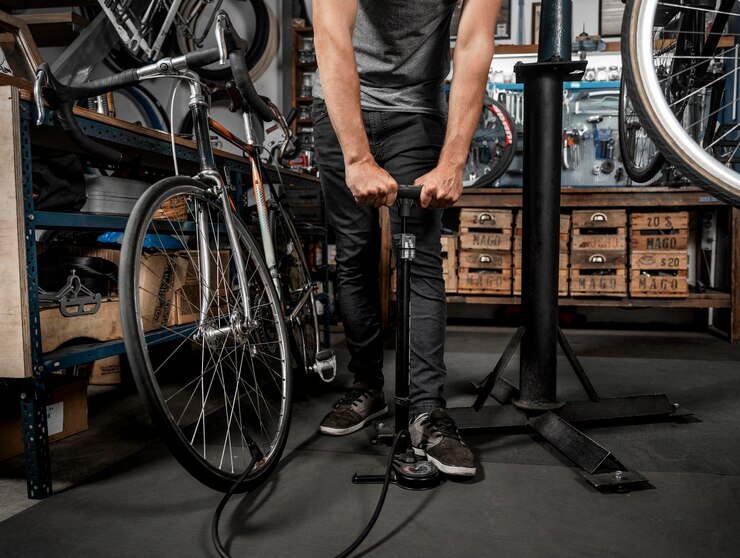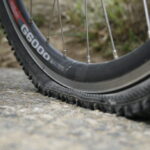Whether you’re new to riding or an expert rider, knowing how to pump a bike tire is an important skill. In this article, we’ll go through the process of correctly inflating bike tires for maximum performance and comfort.
We’ll cover everything you need to know to keep the right tire pressure for your unique riding needs, from selecting the optimum tire pressure to utilizing the appropriate pump and valve.
For a smooth and safe ride, it is crucial to make sure your bike tires are properly inflated. Learning this easy but also important to help you enjoy the ride as well as increase the life of your bike tires and overall safety.
How Often Should I Pump Up My Tires?
Maintaining proper tire pressure is important for both bike performance and safety. While checking and inflating your tires once a week is generally recommended, severe terrain or cold weather might require more frequent attention.

Road bikes with high-pressure tires keep the pressure maintained a bit longer, whereas mountain bikes with wider tires may require more attention. Regular inspections, following appropriate pressure levels, and temperature adjustments will ensure a safe and pleasurable ride.
Type of Tire Nozzles
There are two types of bike tire nozzles: Schrader and Presta. Each nozzle serves a distinct purpose and offers characteristics that cater to various cycling preferences.
Schrader Nozzle
Typically found on most car tires, they are distinguished by their larger diameter and spring-loaded valve core. They are easier to use and more durable, making them suited for various riding circumstances.
Mountain bikes, hybrids, and children’s bikes are best for Schrader valves. You can inflate them using a common air pump found at gas stations or bike stores, making them perfect for casual cyclists.
Presta Nozzle
These valves are narrower, with a threaded valve stem and a lock nut on top. They are common on road bikes, performance bikes, and even mountain bikes.
Presta valves are lighter and allow for higher tire pressures, making them ideal for speed and efficiency-seeking cyclists. To inflate a Presta valve, a pump with a smaller nozzle or an adapter is required. Presta valves are often used in competitive cycling, and the lock nut prevents air leakage during inflation.
Types of Pumps
The two most common types of bike tire pumps are hand pumps and floor pumps, each has its advantages.
Hand Pump
Also known as mini pumps or portable pumps, are small, making them ideal for use anywhere. They are light and simple to transport in a bag or connect to the bike frame.

Hand pumps are best for emergency circumstances, quick refills, and tire repairs while riding. While hand pumps are portable, they may require more work to reach higher pressures and can be time-consuming to fully inflate tires.
Floor Pump
Floor pumps, also known as track pumps, are larger, more powerful pumps that are designed to provide efficient tire inflation at home or in the workshop. They are simple to use because they include a firm base, a long hose, and a comfortable grip.

Floor pumps are useful for achieving precise tire pressures, especially on high-psi road bikes. When compared to hand pumps, they require less effort and can quickly inflate tires to the desired level.
How to Pump a Bike Tire Using Floor Pump?
Pumping a bike tire with a floor pump is a simple technique that works with both Schrader and Presta valve nozzles. Follow these thorough measures to ensure successful inflation:
1. Set Up Pump
Before you begin, make sure your floor pump has a dual-head nozzle that can accommodate both Schrader and Presta valves. This adjustable nozzle design allows you to effortlessly swap between valve types and usually has a flip-down lever for easy adjustment.
2. Take off Valve Cap
Firstly, remove the valve cap from the bike tire. Put the cap somewhere safe because you’ll need it to cover the valve after inflation.

3. Determine Valve Type
It is vital to differentiate between Schrader and Presta valves. Presta valves are narrower and have a lock nut at the top, whereas Schrader valves have a larger diameter with a central pin.
4. Choose a Nozzle End
Choose the proper nozzle end from the dual head according to your valve type. If it’s a Presta valve, release the top lock nut slightly to allow air to flow during inflation.
5. Attach Nozzle
Press the chosen nozzle end against the valve to ensure a tight and secure fit. If you’re dealing with a Presta valve, you’ll need to apply a little more pressure to open it.

6. Lock Nozzle
Some floor pumps contain a lever mechanism that secures the nozzle to the valve. Flipping the lever up produces an airtight seal, preventing air from leaking during inflation.
7. Inflate Tire
Begin the inflation process by pushing down on the pump handle and then lifting it. This motion inflates the tire. Keep an eye on the pressure meter on the pump to follow the tire’s inflation progress.
8. Monitor Pressure
Inflation requirements differ based on the type of valve. Pump until the desired pressure is obtained for Schrader valves. When using Presta valves, keep an eye on the pressure gauge and listen for any hissing sounds.
Presta valves require more pressure, and air may not escape until the necessary pressure level is reached.
9. Unlock and Remove Nozzle
Unlock the nozzle by flipping the lever down (if applicable) once the tire has reached the required pressure. Gently twist and draw the nozzle away from the valve to ensure a seamless disengagement.
10. Tighten Lock Nut (Presta Only)
Tighten the lock nut at the top of the valve, if using a Presta valve. This procedure aids in the prevention of air loss after inflation. Then finally screw the valve cap back onto the valve to protect it from dust, dirt, and moisture.

By following these detailed procedures, you will be able to confidently and competently inflate your bike tires using a floor pump, regardless of whether your bike has a Schrader or Presta valve.
How to Pump a Bike Tire Using Hand Pump?
Inflating a bike tire using a hand pump is a useful skill that every rider should know, as it accommodates both Schrader and Presta valve nozzles. Here’s a thorough guide to refilling your bike tire with a hand pump:
1. Choose Compatible Hand Pump
Choose a hand pump with a dual-head nozzle that is suitable with both Schrader and Presta valves. This adaptable nozzle allows for a smooth transition between valve types.

2. Take off Valve Cap
Begin by removing the valve cover from your tire’s valve and putting it somewhere safe.
3. Determine Valve Type
Differentiate between Schrader and Presta valves. Schrader valves have a wider diameter and a center pin, whereas Presta valves are narrower and feature a top lock nut.
4. Select the Appropriate Nozzle End
Choose the proper nozzle end from the dual head based on your valve type. To allow airflow during inflation, slightly loosen the lock nut on Presta valves.
5. Attach Nozzle
Press the selected nozzle end onto the valve to ensure a snug and secure fit. When using a Presta valve, expect to apply more pressure to open the valve.

6. Begin inflating
Start pumping using the handle of the hand pump. Pull the handle up and down, forcing air into the tire. Keep an eye on the pressure indicator on the pump to track the progress of tire inflation.
7. Monitor Pressure
The inflation requirements vary depending on the type of valve. Pump until the desired pressure is reached for Schrader valves.
Keep an eye on the pressure gauge and listen for any hissing sounds while using Presta valves. Presta valves often need more pressure, and air may not escape until the appropriate pressure is reached.
8. Disconnect Nozzle
Once the tire has reached the desired pressure, twist and remove the nozzle away from the valve. Ensure a smooth disconnection.
9. Tighten Lock Nut (Only For Presta)
If you’re using a Presta valve, tighten the lock nut at the top of the valve to prevent air leaking.

10. Replace Valve Cap
Finally, screw the valve cap back onto the valve to secure it. This cover protects the valve from dust, dirt, and moisture.
With these complete steps, you will be able to confidently and properly pump your bike tire using a hand pump, accommodating both Schrader and Presta valve nozzles.
What Pressure (psi) Should My Bike Tires Be?
When choosing the optimal tire pressure, keep your weight, riding style, and terrain in consideration. In tubeless setups, pressures may be slightly lower, enhancing grip and control on varied surfaces.
Following are the recommended air pressure for different types of bikes:
- Mountain Bike: 25-40 psi
- Road Bikes: 80-130 psi.
- Gravel Bikes: 40-60 psi
- Hybrid Bikes: 50-70 psi
How to Pump a Tire Without a Pump?
When a dedicated bike pump is not accessible, numerous other ways for inflating a bike tire can be used. A CO2 inflator is a small instrument that uses compressed carbon dioxide cartridges to provide quick and portable inflation.
Gas station air pumps with interchangeable valve attachments can also be used. Visiting a neighborhood bike store or repair station gives you access to professional-grade pumps as well as experienced advice.
Manual inflation can be accomplished by squeezing the valve stem while squeezing the tire with your hands or feet, very slowly. Furthermore, if you have access to a home compressor or air compressor, it can be used as a temporary pump with an appropriate valve adapter.
While these options are useful in an emergency, having a dedicated bike pump for regular tire maintenance remains the recommended and efficient solution.
How Does Bike Pump Work?
A pump is a mechanical device used to push air into various objects, including bicycle tires. For bicycle tires, it normally consists of a cylindrical chamber with a handle, a piston, and a nozzle.

When the pump handle is lifted, a vacuum is created within the chamber, causing the piston to rise. The piston compresses the air when the handle is pushed down, increasing its pressure.
After that, the air is sent via the nozzle and into the tire valve, inflating the tire. The pump’s one-way valve prevents air from escaping during the upstroke of the handle. Repeat this procedure until the desired pressure is met.
Pumps of various types, such as floor pumps, hand pumps, and CO2 inflators, use similar principles but differ in design and efficiency. These are necessary for guaranteeing proper tire pressure and a safe and comfortable bike experience.
Conclusion
When tires are used frequently, they tend to lose air. You can use a pump on your own, and while it may be simple and appear easy, doing it incorrectly could severely damage your bike’s tires.
You must check tire pressure regularly, use the proper pump and valve, and follow the recommended pressure levels for your bike type and riding conditions. Now you know how to pump a bike tire.
Using this simple yet pertinent guide, you’ll be able to enjoy smoother rides, better traction, and a more enjoyable biking experience.
FAQs
Unscrew the cap to expose the metal pin, place the air pressure tool’s nipple at the back, then firmly press it onto the pin to release air from the tire.
It is best to inspect and inflate your bike tires weekly to maintain their performance, safety, and comfort levels.
Pay attention to the bike tires’ sound. A properly inflated tire will make a consistent and smooth sound, whereas an underinflated one will make a thumping or fluttering sound.
The majority of floor pumps will have two nozzle holes, a small hole for Presta valve and a big one for Schraeder valve.



